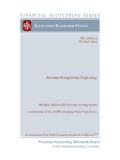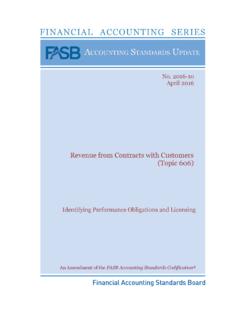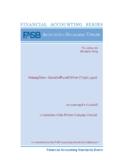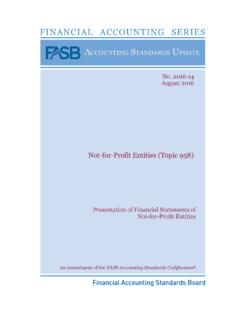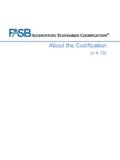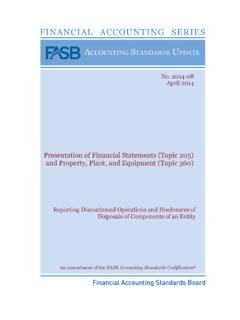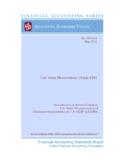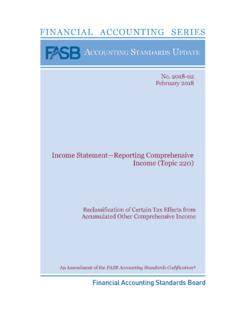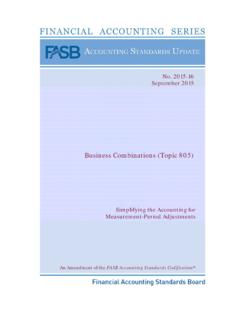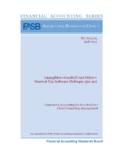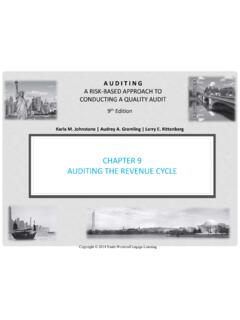Transcription of Accounting Standards - FASB
1 Notice to Constituents (v ) Accounting Standards Codification About the Codification 2009 Financial Accounting Foundation 1 of 44 FASB Accounting Standards Codification Notice to Constituents (v ) About the Codification Notice to Constituent version numbers - The Notice to Constituents contains a version number indicating the degree of change within a particular version. Versions ending with ".0" represent substantive changes to the text, whereas versions ending with a number other than zero represent editorial or clerical corrections. Page FASB Accounting Standards Codification ..4 Codification Goals ..5 Codification Research System ..6 Content Population of codified Standards as of July 1, Standards issued by standard setters other than the SEC.
2 7 Standards issued by the Essential and nonessential content ..9 Cross-referencing between Standards and the Codification ..9 Grandfathered content excluded from the Codification as of July 1, 2009 .. 10 General .. 10 Business 10 Income Taxes .. 10 Pensio ns .. 10 Transition guidance for first-time adopters of US GAAP .. 11 Non-GAAP .. 11 Governmental Accounting Standards .. 11 Audit guidance .. 11 Structure and Style Matters .. 12 Topical structure .. 12 Illustration of the hierarchy .. 12 Topics .. 12 Subtopics .. 13 Sections .. 14 December 18, 2009 (v ) 2009 Financial Accounting Foundation 2 of 44 Subsections .. 20 Paragraph groups .. 20 Paragraphs .. 21 Classification codes .. 21 Referencing the Codification in footnotes and other documents.
3 21 Broad references in footnotes .. 21 Detailed references in other 22 Content-related structure and style matters .. 22 Intersecting content .. 22 Editorial Standards , style, and other matters .. 22 Glossary .. 25 Use of [Not used] .. 25 Fair value option .. 25 Related Party Disclosures Topic .. 25 Fair Value Measurement Topic .. 25 Codification Research System .. 26 Joining and combining content .. 26 General Codification matters .. 28 Materialit 28 Use of Standards by analogy .. 28 Laws, rules, and regulations .. 28 Ongoing standard-setting process .. 29 Effective date and superseded Standards .. 29 Ongoing standard-setting process .. 29 Pending Content .. 30 Maintenance Updates .. 30 Feedback .. 31 XBRL (eXtensible Business Reporting Language).
4 32 Background .. 32 Codification references and links contained in the taxonomy .. 32 XBRL elements contained in the Codification .. 33 Appendix A Project Background and Codification Process .. 34 Project background .. 34 December 18, 2009 (v ) 2009 Financial Accounting Foundation 3 of 44 Events leading to the project .. 34 Compelling reasons to pursue a Codification .. 34 Project approval .. 35 Codification process .. 35 Planning .. 35 Individuals and entities involved in the development of the Codification .. 37 38 Verification .. 40 Appendix B Sequence numbers .. 41 Appendix C Replacement of Standard Language .. 42 December 18, 2009 (v ) 2009 Financial Accounting Foundation 4 of 44 FASB Accounting Standards Codification Welcome to the Financial Accounting Standards Board (FASB) Accounting Standards Codification (Codification).
5 The FASB Accounting Standards CodificationTM is the source of authoritative generally accepted Accounting principles (GAAP) recognized by the FASB to be applied to nongovernmental entities. The Codification is effective for interim and annual periods ending after September 15, 2009. All previous level (a)-(d) US GAAP Standards issued by a standard setter are superseded. Level (a)-(d) US GAAP refers to the previous Accounting hierarchy. All other Accounting literature not included in the Codification will be considered nonauthoritative. See Codification Topic 105, Generally Accepted Accounting Principles, for additional details. The Codification is the result of a major 5-year project involving more than 200 people from multiple entities.
6 The Codification structure is significantly different from the structure of previous Standards . This Notice to Constituents provides information that will help in obtaining a good understanding of the Codification structure, content, style, and history. December 18, 2009 (v ) 2009 Financial Accounting Foundation 5 of 44 Codification Goals The FASB had three primary goals in developing the Codification: 1. Simplify user access by codifying all authoritative US GAAP in one spot. 2. Ensure that the codified content accurately represented authoritative US GAAP as of July 1, 2009. 3. Create a codification research system that is up to date for the released results of standard-setting activity. Simplifying user access to all authoritative US GAAP required a structural overhaul that changed from a Standards -based model (with thousands of individual Standards ) to a topically based model (with roughly 90 topics).
7 As discussed in the section of this Notice tit led Content Matters, the authoritative version of the Codification released on July 1, 2009, includes all level (a)-(d) US GAAP Standards issued by a standard setter. The Codification does not codify nonauthoritative US GAAP such as practice, textbooks, articles, and other similar content. Codifying the vast amount of previous Standards was a combination of art and science. As a means of ensuring that the codified content accurately represents Standards as of July 1, 2009, the FASB instituted several levels of review and also used a monitoring system to track all activity. However, as discussed at a meeting of the FASB, combining disparate Standards into a codified format introduces the possibility of unintentional changes.
8 The Board believes that the level of unintentional changes will be limited, but the FASB staff will evaluate any such assertions by users and advise the Board as necessary. In addition to developing the Codification, the FASB developed the FASB Accounting Standards Codification Research System (Codification Research System) to streamline the research process. The FASB's intent is to update the Codification Research System concurrent with the release of the results of standard-setting activities ( Accounting Standards Updates as discussed latter in this Notice) to ensure that users have the benefit of the most current content. Among other things, the Codification is expected to: 1. Reduce the amount of time and effort required to solve an Accounting research issue 2.
9 Mit igate the risk of noncompliance through improved usability of the literature 3. Provide accurate information with real-time updates as Accounting Standards Updates are released 4. Assist the FASB with the research and convergence efforts. December 18, 2009 (v ) 2009 Financial Accounting Foundation 6 of 44 Codification Research System As mentioned previously, the FASB developed the FASB Accounting Standards Codification Research System (Codification Research System) to streamline the research process. The Codification Research System has numerous features to assist subscribers with research, and the home page includes a link to an online tutorial that describes how to use the system. The benefit of performing research using the Codification is that users will be able to identify all related content in one location much more easily than researching the thousands of previous Standards .
10 The FASB suggests the following steps when conducting research: 1. Browse the topical structure and related tables of contents. Because all related content is organized topically, users should be able to identify most content by topical browsing. Based on direct feedback, more than ninety percent of users responded that they know the topic that they need to research. 2. Subscribers should use the text search feature only for very specific items (for example, guidance about inducements). Text search is based on specific language. Deviations from a selected search expression will lead to certain relevant content being excluded from search results. The Codification Research System does incorporate certain tools to help overcome the issue, but searching will always be constrained.
